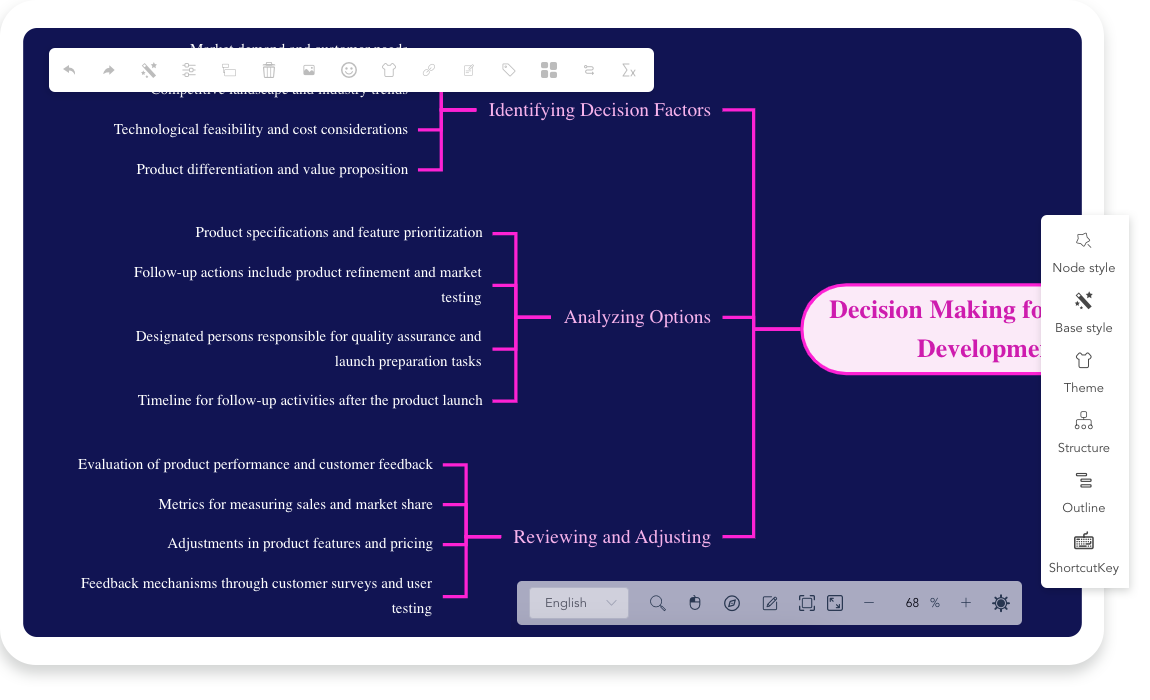Mind mapping is a powerful visual thinking and planning tool that has gained widespread popularity across various industries and applications. This case study explores how a global software company, XYZ Corp, utilized mind mapping to enhance their project planning and collaboration processes.
The Challenge
XYZ Corp, a leading provider of enterprise software solutions, faced challenges in effectively planning and coordinating their complex, cross-functional projects. The company’s project teams struggled to capture and organize project requirements, identify dependencies, and communicate the project roadmap effectively with stakeholders.
The Mind Mapping Solution
To address these challenges, XYZ Corp decided to implement a mind mapping tool, Visual Paradigm Online, as a central hub for their project planning and collaboration efforts.
Step-by-Step Implementation
- Establishing a Mind Mapping Process:
- XYZ Corp’s project management team collaborated to develop a standardized mind mapping process for project planning.
- They identified key project phases, milestones, and required information to be captured in the mind maps.
- The team also established guidelines for mind map structure, node labeling, and visual formatting to ensure consistency across projects.
- Onboarding and Training:
- The company provided comprehensive training sessions to all project team members on the basics of mind mapping and the use of Visual Paradigm Online.
- The training covered mind mapping techniques, best practices, and the specific implementation within XYZ Corp’s project management framework.
- Collaborative Mind Mapping:
- Project teams used Visual Paradigm Online to collaboratively build and maintain mind maps for their projects.
- Team members could access and contribute to the mind maps in real-time, fostering cross-functional collaboration and information sharing.
- The mind maps were used to capture project requirements, timelines, dependencies, and resource allocations.
- Stakeholder Engagement:
- XYZ Corp leveraged the visual nature of mind maps to effectively communicate project plans and status updates to stakeholders.
- The mind maps were used as the central reference point for project discussions, allowing stakeholders to easily understand the project scope, timeline, and interdependencies.
- Continuous Improvement:
- The company regularly reviewed the effectiveness of their mind mapping process and made adjustments based on feedback from project teams and stakeholders.
- They incorporated new best practices and explored additional features of Visual Paradigm Online to enhance the mind mapping experience.
Possible Application Areas for Mind mapping
The implementation of mind mapping at XYZ Corp had a significant impact on various aspects of their project management and collaborative efforts:
- Project Planning and Scoping:
- Mind maps helped project teams to clearly capture and organize project requirements, milestones, and deliverables.
- The visual nature of mind maps enabled better identification of dependencies and potential risks.
- Team Collaboration and Communication:
- The online, collaborative mind mapping platform facilitated seamless information sharing and coordination among cross-functional team members.
- It enhanced the team’s ability to align on project goals, roles, and responsibilities.
- Stakeholder Engagement and Reporting:
- Mind maps provided a concise and visually appealing way to present project plans and progress to stakeholders.
- The interactive mind maps allowed stakeholders to better understand the project’s scope, timeline, and interdependencies.
- Knowledge Capture and Retention:
- The mind maps served as a centralized repository for project-related knowledge, ensuring that critical information was documented and accessible to the team.
- This facilitated knowledge sharing and enabled smoother onboarding of new team members.
Outcomes and Benefits
The implementation of mind mapping at XYZ Corp resulted in the following key benefits:
- Improved project planning and coordination: Mind maps enabled the project teams to better capture, organize, and communicate project requirements, timelines, and dependencies.
- Enhanced cross-functional collaboration: The online, collaborative mind mapping platform fostered seamless information sharing and alignment among team members.
- Effective stakeholder engagement: Mind maps provided a visually engaging and intuitive way to present project plans and status updates to stakeholders.
- Increased knowledge retention and transfer: The mind maps served as a centralized repository for project-related knowledge, facilitating knowledge sharing and onboarding.
- Streamlined project management processes: The standardized mind mapping process and the use of Visual Paradigm Online increased the efficiency and consistency of XYZ Corp’s project management practices.

Conclusion
The successful implementation of mind mapping at XYZ Corp demonstrates the versatility and benefits of this visual thinking tool in the realm of project planning and collaboration. By leveraging mind mapping, the company was able to enhance its project management capabilities, foster cross-functional teamwork, and improve stakeholder engagement – ultimately driving greater project success and organizational effectiveness.
